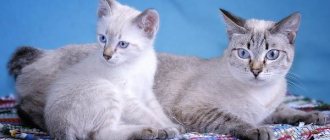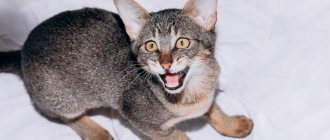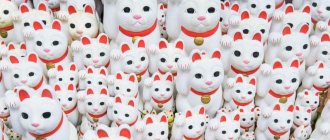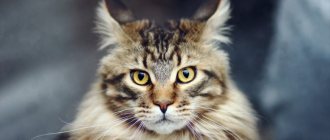The Mekong Thai Bobtail is a true aristocrat of the cat world. The dark muzzle of this mysterious Asian resembles the Siamese breed, but there are still significant differences, for example, a “broken” tail with unusual loops. Mekong Bobtail cats resemble dogs in their active behavior. They are able to follow commands, bring various objects in their teeth, and can walk on a leash.
Legends
The appearance of the animals - a broken spiral tail and slightly slanted eyes - has given rise to many legends about their origin:
- Southeast Asia is famous for its magnificent temples. The monks used cats as guards for ancient priceless temple vases. The animal wrapped its tail around them and carefully watched so that no one approached the vase. Over time, the tail acquired corresponding bends, and the eyes became slanted.
- The second legend tells about a fearless representative of the Mekong bobtail breed. The animal rushed in pursuit of the thieves who stole the king's golden cup. The cat was able to take the treasure. While waiting for help, she wrapped her tail around the cup for safety and sat in this position for several days. The precious vessel was safely returned to its owner, but the tail remained bent.
- The most popular version is about using curled ponytails as “storage” for royal jewelry. During bathing, princesses entrusted their jewelry to cats. Bracelets and rings on such a tail were never lost.
History of creation
Short-tailed Mekongs are a natural mutation that originated in Southeast Asia. The progenitors of this breed are Thai cats. Until the 10th century, they were not exported outside the country at all. The first kittens appeared in Japan, then came to Europe. They were presented as an original gift to representatives of foreign countries.
Individuals of the Siamese breed with non-standard tails were not recognized in Europe. Russian breeders saved the situation. They worked hard to consolidate the unusual feature. In 1994, the Russians approved the breed standard. At the beginning of the twenty-first century, the Mekong bobtail breed was officially recognized. Its representatives received their name in honor of the Mekong River, which flows through Laos, China, Vietnam and Cambodia.
Recognition by the WCF (the international felinological association, which includes Belarus, Kazakhstan, Kyrgyzstan, Moldova, and Russia) allowed representatives of the breeds to be exhibited at international exhibitions. European experts are wary of the Mekong, believing that a broken tail can affect the health of the animals. Russian geneticists claim that this is a manifestation of a natural genetic mutation, artificially fixed by man, and does not affect the physical condition of individuals in any way.
Buying a Kurilian Bobtail
If you already see yourself as the owner of a Kuril Bobtail, the next natural step is to find out how much such an animal costs. The great demand for representatives of this breed and its many advantages determine the high price of kittens. Its lower limit is around $300 US, but it can reach up to $1200.
The price is determined by many factors, including:
- gender of the animal;
- his ancestry;
- admixture of “wild” blood;
- close to the standard of appearance and color.
The most expensive kittens are those that were delivered to the mainland directly from the Kuril Islands, taking the animals from their natural environment. But there are many dangers in acquiring such individuals. They are sold without documents, so you will have to spend a lot of time on the official registration procedure.
It is better to purchase a bobtail from a breeder, then there will be no problems with confirming its origin. No one will prohibit you from buying an animal at a more attractive price, but here you will act at your own peril and risk, because the seller will not provide guarantees that the kitten is truly purebred.
Price
The price for a Thai bobtail ranges from 5,000 to 35,000 rubles.
The owners decide on their own the question “where to buy a Thai Bobtail kitten”, but buying it second hand does not guarantee the purchase of a purebred kitten.
Description
This breed is endowed with intelligence and innate worldly wisdom. Its representatives resemble Siamese animals. They differ in body structure and, of course, the shape of the tail, from which you can immediately determine that this is a Mekong Bobtail. Its description is as follows:
- Head. Round, slightly wedge-shaped, flat on top, with a well-developed chin. The transition to the nose is just below eye level, the nose itself is without a hump. The ears are wide at the base, rounded, set high, of medium size. The distance between them is less than the width of the ear. The eyes are oval, intense blue, a slight slant is welcome.
- Torso. Medium size, compact, rectangular in shape. Combines grace and muscular strength. The slender body has a straight line of the back with a subtle rise towards the croup. Females look more graceful and have a proud posture. Weight does not exceed 4.5 kg, height at withers is on average 30 cm.
- Limbs. Medium height, oval-shaped paws. Only the Mekgongs do not have fully retractable claws on their hind paws.
- Wool. Close-lying, short, silky, practically without undercoat. Kittens are most often born light-colored without markings. Acceptable color is any color except white.
- Lifespan. They live a long time, up to 25 years, puberty occurs at 7 months.
- Tail. It has at least three nodes (a smaller number does not allow the individual to be classified as this breed), the length does not exceed one-fourth of the length of the animal’s body. There is a certain classification for ponytails:
— retracted: the number of vertebrae is up to seven, straight, with a squiggle at the tip – the result of deformation of the vertebrae;
— stump: very short, vertebrae fused, can be arranged spirally;
— spiral: the number of vertebrae reaches 15 pieces, the breaks form a clear spiral;
- panicle: may consist of 10 vertebrae, breaks at an obtuse angle.
All of the above options and other types of tails can be stationary, sedentary or mobile. The Mekong Bobtail does not have a strictly defined tail shape; there are no standards. Each cat has its own unique combination of knots, bends and other squiggles. There is a strict rule regarding the first break - always at the base.
Tail shape
The animal's tail is a source of pride for the owner of the Kurilian Bobtail
At exhibitions, all attention will be focused on him. Its shape is individual and unique
There are several types of Kuril Bobtail tails:
- "spiral". Visually, it reaches 5-10 cm in length. It consists of 3 to 15 vertebrae. They are badly broken in many places. Sometimes the fracture occurs at a very sharp angle. The junctions of the vertebrae are mobile or partially mobile;
- "panicle". Its length is 5-15 cm. It is formed by 5-10 vertebrae curved at obtuse angles. Their junctions are semi-movable;
- "stump". This tail most closely resembles a pompom. It is very short (2-5 cm). It consists of 2-8 vertebrae broken at obtuse angles, as if placed one on top of the other. They are connected motionlessly;
- “retracted bobtail” or “squiggle”. An interesting shape, in which a small part of the tail has a traditional structure (5-7 vertebrae at its base). The remaining vertebrae break at different angles along their entire length. The places of their connection can have any mobility.
Breeding
The cat goes into heat several times a year, so the owner can choose a convenient time for mating animals and producing offspring, depending on the season and plans for participating in exhibitions.
Be sure to read:
The Korat is a domestic cat native to the province of Thailand with olive green eyes.
Mating and partner selection
For the first mating, an experienced cat of a dominant character is selected. There is a practice of arranging a cat date on the cat's territory or in a neutral zone. Usually the couple is left alone for 1 to 3 days.
During the mating process, the cat can bite the cat’s withers quite strongly, and dark fur grows for a long time in place of the healed wounds.
For the first mating, an experienced cat of a dominant character is selected
A spot on the white fur does not improve the show appearance of the animal, so it is better to obtain the necessary titles at exhibitions in advance, and then start breeding offspring.
The cat should not belong to a closely related line; crossing such animals is prohibited - this will lead to severe hereditary diseases in the offspring.
Pregnancy and childbirth
Feeding a cat during pregnancy should be balanced, adjusted for the body's increased need for nutrients, vitamins and microelements.
An excellent solution is to switch to specialized premium food for pregnant and lactating cats.
The best reproductive period for a purebred animal is from 1 year to the age of seven or eight years. Although Mekongs are fertile until the age of 20-22, the stress on an older cat's body is too great.
Cats give birth on their own, but since they are not large in size, the owner must control the process to avoid complications.
Feeding a cat during pregnancy should be balanced
If labor subsides, you can stimulate it yourself (oxytocin injection 1.5 ml per cat weighing 2.5 kg no more than 1 time per hour, but no more than 2-3 times).
But this should be done only after consulting a veterinarian. If this does not help, you should immediately take your pet to a veterinary clinic for a cesarean section.
When labor is rapid, the cat does not have time to free the kittens from the placenta and mucus. You need to do this for her, free the kitten’s airways from liquid, rub the kitten’s body and place it on a warm heating pad.
Suit
For the Mekong, seal point is considered a classic color. It is the most stable of its type. The following colors are allowed: tortie and tabby varieties, cream, blue, chocolate, red, lilac, lynx. Breeders are working to develop lilac and gold shades.
The most common colors:
- Seal-point. The general background is cream, the mask and markings on the paws are black.
- Red-point. Rare color. Against the background of snow-white skin there is a fiery red mask and “gloves”. The main white color may slightly shimmer with a peach tint.
- Tortie-point. Nature rewards only cats with this tortoiseshell “outfit.”
- Blue-point. The body is covered with silver hair, the mask and the color of the legs are bluish or pink. Quite a rare color.
- Chocolite-point. The general background is cream or snow-white, the markings are chocolate-colored. The peculiarity of this suit is the lilac or purple tint of the eyes of animals.
- Tabby-point. On a white or lightly tinted background with tabby markings and a variety of lace patterns. A prerequisite is the presence of a mark in the form of the letter “M” on the muzzle. The accuracy and clarity of the drawing is valued.
Colors
The colors of the breed are very diverse, the most popular are:
- - a combination of sunny peach and red, point with the main peach - red point, expressive, perky bright and as if from rays of light. This is a rare color and therefore in demand.
- - precious mink fur with a pearl-gray tint - blue point. Provides the basis for the even rarer chocolate point.
- -Siamese or color-point, allowing all shades in addition to white. When born white, kittens begin to darken (face, ears, paws) within a matter of hours. The fur coat acquires a grayish-white or cream tint, further color changes continue until puberty.
- -tabby point, striped bobtail (points look like they were painted).
- - Seal Points are widespread, their body is a creamy delicate tone, contrasting with the paws with a triangle of ears and a nose triangle.
- - a rare tortie point. Tortoiseshell color obtained in 2011.
A unique pet of this species is the cat Iris (translated from English as rainbow). It is assumed that the resulting offspring will have a dozen different, most outlandish combinations for the Mekong.
Feeding
The Mekong Bobtail is a breed that is not particularly picky about food. Cats live quietly on ready-made food and homemade food. They feed twice a day. Access to clean water at room temperature should be constant. Animals prefer to drink from deep containers. When choosing industrial feed, you should choose high-quality premium products. It is difficult to overfeed Mekongs; they are not greedy for food and do not suffer from obesity.
When feeding natural products, you need to remember a few rules:
- Do not give milk, fatty meat and fish;
- all natural products, regardless of origin (meat, dairy) cannot contain more than 10% fat;
- meat products must be fresh;
- pork and liver are contraindicated for bobtails;
- river fish is allowed only in boiled form;
- pollock and cod are not welcome in the diet;
- food containing a lot of copper and magnesium leads to dullness and darkening of the coat color;
- It is not recommended to give beets and cabbage as vegetables.
Vegetables are grated and mixed with fish or meat. Animals eat cottage cheese, eggs, kefir, meat, offal, vegetables and fruits well.
Castration and sterilization
To avoid unwanted matings, all bobtails that do not meet breed standards or have health problems should be spayed or neutered.
At what age is it recommended to do it?
Although Mekong Bobtails mature early, this does not mean they should be spayed or neutered early. They may not be fully developed physically yet, so surgery should not be performed too early. The puppy may be developmentally delayed and severely stunted. The optimal age is 10-12 months.
Caring for your pet after surgery
Postoperative care should be as follows:
- Immediately after surgery, ensure that the animal is wearing a poncho or collar to prevent damage to the stitches;
- Make sure the animal is in a quiet and peaceful place (away from children);
- Do not feed for 10-12 hours after surgery;
- Limit your cat's mobility as much as possible;
- Once a day, treat the seams with disinfectant solutions (chlorhexidine, hydrogen peroxide, brilliant green).
After the operation, he should be covered with a special collar or blanket.
The animal should be closely monitored, and if any suspicious symptoms appear (high body temperature, stitches, etc.), you should immediately contact a veterinarian.
Content
The Mekong Bobtail (reviews from happy cat owners are unanimous in this regard) do not require special care. They do not cause much trouble: they do not mark their territory, do not meow loudly, and are friendly and sociable.
The animals are very clean and easily litter trained. It is enough to comb the coat during shedding, which goes almost unnoticed. Animals are washed as their fur gets dirty, but not more than twice a month. If you categorically reject the bathing procedure, the animal can be wiped with wet wipes.
Ear care involves regular (once a month) cleaning of visible dirt. Animals need trimming of the claws on their hind paws (if they grow up to 3 cm). This procedure requires attention and care to avoid damaging nerve endings and blood vessels.
Bobtails can easily tolerate car trips and can accompany their owner on walks, walking like a dog on a leash. Moving to a new place of residence will not cause panic either; cats get used to people more than to their habitat.
Care and maintenance of the Mekong Bobtail
Caring for Thai bobtails is not particularly difficult and will not take much time from the owners:
- To keep the coat in order, no special procedures are required. Some breeders recommend not bathing animals at all, because they are quite clean and can easily handle hygiene themselves. It is only necessary to ensure that parasites do not appear on your pet’s fur.
- But the ears and claws of Mekong Bobtails require regular care. The ears must be cleaned as they become dirty with special solutions that can be purchased at a veterinary pharmacy. This must be done carefully, without touching the membrane. It is recommended to trim the nails once every 2-3 weeks, trimming only the stratum corneum, so as not to cause pain to the animal.
- The pet will not need special nutrition - it is important that it is balanced and the body receives all the necessary substances and microelements in sufficient quantities.
Diseases of Mekong Bobtails
Veterinarians agree that Mekong Bobtails have excellent health . They do not have any genetic diseases, but are still predisposed to diseases such as gingivitis. This is a disease of the oral cavity, which can be noticed by the appearance of an unpleasant odor from the mouth, the appearance of inflammation and bleeding of the gums, and an increase in the intensity of saliva secretion.
Conclusions about the Mekong breed
global $ads_google;
//data-ad-slot=”2475549904″ $ads_google = empty($ads_google) ? false : true; ?> if ($ads_google == false) {?> $ads_google = true; ?> } ?> These wonderful pets have an ancient history, although they were recognized as an independent breed relatively recently. It cannot be confused with others, thanks to its interesting shortened tail, which bends and twists bizarrely.
Once upon a time they lived in the sacred temples of Siam and the palaces of rulers, and today the Mekong Bobtail can be purchased at a nursery and kept at home.
In everyday life, these pets show only positive qualities, happily playing with their owner and communicating with him. Despite all the exoticism of these animals, they are not demanding in terms of conditions and feeding.
Kittens
Kittens of this breed are no different from others in the process of adaptation to a new home. They need to allocate a place where the kitten will spend time until it is time to introduce him to the whole house. The baby must be provided with a house or bedding, a tray, bowls for food and water, and toys. If there are other pets in the house, there is no need to rush to introduce them to the new resident; this should be done a week or two after the kitten settles in the new place.
For the safe living of the baby, you must follow the following rules:
- The balcony and windows in the room where the furry pet lives must be closed. If you need to keep the windows open, there should be a mosquito net on them.
- Poisonous plants and dangerous objects must be removed from the room. The wires must be carefully masked.
- There should be no draft in the room; the room must be kept warm.
- Threads and plastic bags are bad toys. Tubular bones should also not be given to a kitten.
- The washing machine should always be closed: the kitten can hide there and go unnoticed.
- It is necessary to ensure that the animal does not climb under low-bottomed furniture.
Reproduction and lifespan
A Mekong Bobtail cat the first signs of interest in the other sex as early as 4 months, when the first heat comes. If you want to get healthy kittens, wait until estrus 3; before that, the “girl’s” body may not be able to cope with pregnancy. A pussy that is too young cannot bear fruit. Pregnancy lasts 63 days.
Mekong Bobtail kittens are sociable and very active. They are completely “immersed” in domestic relationships. They are interested in everything, they are inquisitive. When choosing a kitten, look at its surroundings. It absorbs the atmosphere like a sponge. If the house is clean and tidy, the mother is well-groomed and calm, you can start choosing a new friend.
By the way, Mekong cats are very responsible and careful mothers during the feeding period. At this moment, they try not to let even their beloved owner near the children. But then the father will take care of the upbringing, he will give them life skills - going to the cat litter, trying new food.
And the parent only feeds and makes sure that order reigns in the upbringing. Otherwise, no one can avoid “cracks.” Still, she is the head of the family. They can produce offspring even in old age. They live up to 20-25 years.
Character
It is not for nothing that former dog lovers choose the Mekong Bobtail breed. The nature of their behavior is close to that of a dog. They do not “walk on their own”, preferring the company of their owner. A knock or bell on the door turns the cat into a formidable guard: he stands in a defensive position and emits a threatening grunt. If he feels hostility towards the guest, he may attack.
Wild ancestors endowed the Mekong with powerful hunting instincts. They jump superbly, are agile, and have lightning-fast reactions. Insects will not fly or crawl in the apartment; cats will simply destroy them. The same fate awaits fish, any rodents and birds. They will not accept them into their family, but will consider them lawful game. But bobtails get along well with dogs.
Cats lead both their offspring and their cats. They are sedate and dignified. The Mekong Bobtail dad is raising the children. The kittens learn all the cat wisdom from him. Age does not take them away; they remain playful until old age.
The animals are sociable, love to sit in your arms and “talk.” Moreover, for each specific situation they choose the appropriate timbre. They are easy to train and can fetch slippers or fetch. They are patient with children and tolerate all their manifestations of love.
Education and physical activity
Thai Bobtails are active and jumping cats, they love hunting and walking. To maintain physical fitness, the Mekongs are equipped with a corner with tunnels, ladders and shelves on which they can climb. So that cats of this breed can realize their hunting instinct, they are given several interactive toys.
Mekongs are distinguished by high intelligence and good memory. They are easy to train and easily learn not only the rules of cat etiquette, but also remember different commands.
Where did the bobtail lose its tail?
Kuril Bobtail cats are natives of the Kuril Islands, economic assistants to the residents of the Far Eastern region. For a long time they remained on the islands, and few people on the mainland knew about them
But selection could not deprive such a unique miracle of nature of attention.
Without myths and legends
The history of many native breeds in the cat world is shrouded in mystery. Traditions and legends have developed about them. Signs and beliefs are associated with them. But about the Kurilians, popular rumor cannot tell any tales that would at least somehow hint where the wonderful cat’s tail went.
Even for the most distinguished representatives of the Kuril Bobtail family, the history of the breed began only at the end of the 20th century. And before that - long island days with fishing and crabs and hunting small game in the coastal thickets.
Japanese genes or your own mutations?
A short tail is a genetic anomaly, which, once it occurs, is necessarily fixed in the offspring from the first generation. It so happened that it was the population of cats on the islands closed from the outside world that somehow acquired such a bizarre appearance. Perhaps the reason for this is a harmless mutation of one’s own genetics.
But there is also a suspicion that this gene secretly migrated to the Kuril Islands from Japan, where there are Japanese bobtails. They did not look for genetic evidence of this, but simply continued to develop and improve the breed purposefully. And in the early nineties, the Kurilian Bobtail cat breed received its official status in the Soviet Union. Another 4 years have passed, and here it is, international recognition within the WCF.
Health
The animals are in excellent health. Strong immunity guarantees long life. There are no special diseases specific to this breed. Taking care of your health does not cause problems. Vaccinations, protection against helminths, preventive examinations by veterinarians, and control over proper nutrition are needed.
Reasons for concern and contacting a specialist may include:
- poor appetite;
- inflamed and/or bleeding gums;
- bad breath;
- copious secretion of saliva.
Peculiarities
In the cat kingdom, each breed has its own flavor and unique characteristics:
- The most striking feature of the Mekong Bobtail breed is its tails. It is almost impossible to find individuals with two identical tails, exactly repeating the creases and sizes.
- The Mekongs are distinguished by their life expectancy - up to 25 years. With good care and maintenance, a cat can give birth to kittens even at 21 years of age. The officially registered life record is 38 years.
- The claws on the hind legs do not retract completely. When walking on a hard surface (wood, laminate), they make a characteristic clicking sound, reminiscent of a dog walking.
- This breed has absolute matriarchy. The Mekong Bobtail cat controls not only the offspring, but also the cats. They humbly accept her dominance, never allow themselves to snap at a slap from a lady, and patiently endure all “instructions.”
- When it's hot, the pads of your paws are the first to start sweating.
- Cats do not tolerate loud noise well; they try to leave the discomfort zone.
- In a fight, the teeth are the first to be used as weapons, and only then the claws.
- Children are raised by their “dad,” which is quite a rare occurrence in the animal world.
- These cats use their voice exclusively to communicate with people.
- The skin does not adhere tightly to the muscles, a large gap allows the animal to endure children's hugs painlessly.
How to choose a kitten
When choosing a Mekong Thai Bobtail kitten, you should rely on the following characteristics:
- the body is strong and toned;
- paws of medium size, dense;
- nose with a small hump;
- large oval-shaped eyes;
- tail with an obligatory fracture at the base.
Kittens may be white at birth; the point coloring begins to appear only at one year of age.
The kitten should be curious and playful, moderately well-fed.
This indicates that the pet is healthy.
You should purchase an animal only from nurseries with a good reputation.
Mekong Bobtail cats are considered a fairly rare breed.
Because of this, their prices are too high.
The cost depends on criteria such as the sex of the animal, the presence or absence of CSU documents, etc.
Depending on this, the price varies between 10-50 thousand rubles.
If a pet is purchased for breeding, you should take an animal with a pedigree.
If you are buying a pet for yourself, you can consider cheaper options.
Important! When purchasing a Mekong Bobtail kitten, ask the breeder for a passport with vaccinations.
Interesting facts about the breed
- Mekong bobtails have the beneficial property that their skin can be pulled back freely, which allows even after a snake attack, the venom from the bite remains under the skin and does not enter the bloodstream.
- For a long time, the inhabitants of Siam (Thailand) protected Siamese cats without tails from being exported by foreigners; they were considered a national treasure.
- The Mekong descendants had Siamese cats, the sacred guardians of temples; they were taken into service there for their beauty, intelligence, and courage in the fight against rodents.
- The Guinness Book of Records contains a record of the rarest case of a Mekong Bobtail living up to 38 years.
Vaccinations and antiparasitic treatment
To protect the Mekong from viral and infectious diseases, it is regularly vaccinated against panleukopenia, calcivirosis, rhinotracheitis and rabies. The first vaccination for a Mekong kitten is given at the age of 7-8 weeks and repeated after 28 days. In the future, the pet is vaccinated annually.
To protect the Mekong Bobtail from diseases carried by fleas and helminths, it is regularly subjected to antiparasitic treatment. Protect your cat from fleas using special drops, collars and shampoos. Antihelminthic tablets are given to the Mekong Bobtail twice a year, repeated every 10-14 days.
Choice
It is better to start choosing a Mekong Bobtail kitten with an external examination. It is worth paying attention to the baby’s compliance with breed standards, its color and state of health. Advantages of the breed:
- original appearance;
- short hair does not require special care and sheds little;
- devotion to the owner;
- cleanliness;
- sociability.
For Russia, Mekong dogs are not exotic; they are bred by many breeders, however, the price for them is quite decent. The cost of such a miracle ranges from $200-800 and more. It depends on the origin, availability of documents, reputation of the nursery.
The Mekong Bobtail is native to Southeast Asia. Features of cats of this breed are a short tail and developed intelligence. They easily remember commands, love to walk on a leash and carry newspapers or the owner's slippers in their teeth. Most of these animals live in nurseries in Russia.
History of the origin of the Mekong Bobtail breed
The exact date of origin of this breed is unknown. The animals are native to Thailand. They lived in the royal palace, it was forbidden to take them abroad, because... were national pride. Only in the 19th century. Mekong Bobtail kittens began to be given to foreign diplomats as a sign of friendly intentions and special favor. The first breed standard was approved by Russian breeders in 1994. The breed continues to remain open because new changes to the standards may occur. The name “Mekong Bobtail” was given to cats by the General Assembly in 2004 in Germany. It is connected with the Mekong River, which flows through the territory of Vietnam, China and Laos. The Mekong cat's coloration is similar to that of Siamese cats, which is why they are called Thai Bobtails. But they differ in their short, broken tail.
Description of appearance
The body of animals is rectangular in shape. Males are large and muscular, while male cats have a more fragile and graceful build. Adults weigh 4-6 kg.
Head and body
According to the description, the head of cats of this breed is rounded and wedge-shaped. The pet is characterized by a strong jaw and wide-set small ears, the tips of which are rounded. The eyes are large, slightly slanted, rich blue. The lower eyelid is rounded, the upper is almond-shaped. Body with well-developed muscles. The back is arched, rounded closer to the croup. Limbs of medium length. On the hind paws, the claws are not hidden in the pads, so a clicking sound appears when walking. The main feature of this breed is the tail, which consists of 3-4 vertebrae. It can twist in different ways, but the first bend is always located at the base. The tip is pointed.
Coat and color
The Mekong has short fur. It is shiny, dense, there is no undercoat, so there is no allergy to wool. Kittens are born snow-white, but as they grow older, dark spots appear on their paws and face. The main color of the coat is seal point: the coat is milky cream color, the tail, muzzle and tips of the paws are dark brown. Animals also come in the following colors: 1. Red point. The paws and muzzle are red, and all other parts of the body are peach-colored. 2. Torty point. This is a tortoiseshell color that is found only in females. 3. Blue point. The paws and muzzle are bluish-pink in color, the rest of the fur is silver. 4. Chocolate point. The paws, tail and muzzle are chocolate-colored, the rest of the body is white-cream. 5. Tabby point. The paws and muzzle are striped.
One animal can have different colors, except white.
Cat character
Such cats become very attached to their owner. Their character and habits are unusual and different from other breeds. Pets can bring the owner's favorite toy or leash for a walk. They sense the owner’s mood well and if they see that he is sad, they will jump onto his lap to calm him down with a soft voice. They treat guests with caution. If they hear the doorbell ring, they grunt and take an attacking pose, but attack only in exceptional cases. Animals rarely scratch, but they can bite. They are active, mobile, and prefer to walk on a leash. A cat's favorite pastime is chasing a ball or a stick. Such pets get along well with dogs and get along with children. They are distinguished by curiosity and devotion, following their owner everywhere, even on trips. Cats love to purr and are easy to train - just show them 2 times where the toilet is. They do not tolerate disrespectful treatment, and the physical force used will cause great offense. Animals have a well-developed hunter instinct. They can hunt anything that flies. Another feature of such animals is the dominance of the cat. In the Mekong Bobtail, kittens are licked, litter box trained, and raised by the male. The cats are just watching. Females have a proud, independent and tough character, and if the cat does something wrong, she may even scratch him. Cats are more flexible and softer than cats.
Maintenance and care
Such animals are unpretentious in maintenance and care. They are clean, so it is recommended to comb them only during the molting period. Pets cannot tolerate water treatments. Their fur does not get very dirty, so there is no need to bathe them often. To remove small stains, use special wet wipes. Be sure to perform eye and ear hygiene. Once a month, the ears are cleaned with special products. Once a week, wipe your eyes with cotton pads, which are moistened in tea leaves or boiled water. Nails are trimmed 2 times a month. Teeth are brushed regularly with a pet brush, and gums are treated with a thick, lint-free cloth wrapped around a finger. Mekong is well suited for apartment living. It does not have a specific smell and rarely marks its territory. Kittens are energetic and active, but with age they become calmer and more balanced.
Nutrition
The diet of an adult cat must include meat - turkey, beef, veal, rabbit. Moreover, it is recommended not to stew or boil it, but to serve it raw, after freezing it for 24 hours. Pets do not like chicken, and fresh meat and pork can cause stomach upset. The menu also includes fermented milk products - sour cream, kefir, cottage cheese. Milk cannot be given to Mekongs, because... it is poorly absorbed by the body and leads to intestinal problems. Instead of milk, the animal can be offered baby food. The diet is supplemented with raw eggs, because boiled ones are not absorbed by their body. You can give fish, boiled and fresh vegetables, herbs, and fruits once a week. Vegetables containing large amounts of carbohydrates, such as potatoes, are prohibited. Be sure to give wheat or sprouted oats. It is necessary to offer cats lactobacilli and vitamins that strengthen the immune system and normalize the flow of vital processes in the body. If the owner feeds the Mekong with ready-made food, then preference is given to premium products: Royal Canina, Purina, Akane, Sheba. These foods contain nutrients, carbohydrates, proteins, and vitamins that are required for a cat’s health.
Health
The Mekong Bobtail cat breed has good heredity. She has no genetic diseases. Thanks to timely vaccination and proper care, such pets can live 20-25 years. But the animal also has weak points: teeth and soft tissues of the oral cavity. Pets have a high predisposition to tartar deposits, the development of periodontal disease and gingivitis. To prevent the occurrence of such diseases, it is necessary to brush your gums and teeth. Cats of this breed have a tendency to develop hearing loss, so it is important to monitor the condition of the ears and regularly clean them of wax, dead particles of the epidermis and the accumulation of dust particles. If the animal goes out for a walk, then upon return you need to inspect it for ticks and fleas. Your pet may develop worms, so preventive measures for helminthiasis are systematically carried out. It should be taken to the veterinarian once every 6 months for examination and testing.
How much does a Mekong Bobtail cat cost?
The cost of Mekong Bobtail kittens is influenced by the color and quality of the animal.
Choice of kitten and price
Pets are divided into 3 groups depending on breed qualities: 1. Show class. These are kittens with great potential for show and breeding. They meet the standard as closely as possible. Seal point animals cost 12-20 thousand rubles. The cost of kittens of rare colors is 18-30 thousand rubles. Animals of the rarest colors, which were obtained as a result of complex breeding work, are highly valued. Their cost starts from 35 thousand rubles. 2. Breed class. These are pets that meet the standard and are suitable for breeding, but do not have a very impressive appearance for exhibitions. They may receive titles, but their careers are not very successful. The price of such kittens is 10-15 thousand rubles. 3. Class Pet. These are pets with various defects or shortcomings, because of which they are not used for exhibitions and are not interesting for breeding. The price of such kittens is 5-7 thousand rubles.
What should you pay attention to?
When choosing a Mekong kitten, you need to pay attention to the following points: - it should be moderately well-fed, with a fit and strong body; - the coat is clean, shiny, smooth and pleasant to the touch; - eyes are clear with equal pupils, without clouding; - the nose is clean, without discharge; - paws are small and dense; - the short tail at the base should have a sharp bend or fracture.
The kitten must be active, playful, not limp, fearful or aggressive. Arriving at the nursery, you need to pay attention to the conditions of detention. Animals should not be in cages, because... it affects their psyche. You should purchase a pet with accompanying documents: pedigree, birth certificate or veterinary passport.
Conclusions about the breed
Mekong Bobtails are a cat breed that evokes admiration and delight. They are distinguished by their unpretentiousness in care and food, are easy to train, have a calm character, and play with children and various pets. It is important to give them attention and care.
Nutrition
If you decide to feed your cat regular food, do not add salt or seasonings to his food, take care of his kidneys. They benefit from boiled and raw boneless chicken, lean beef or pork, milk and offal. Some cats love raw and boiled liver. Sometimes cats prefer kefir instead of milk.
It happens that they like to feast on olives, give them only pitted ones, and no more than 2-3 per week. You can't give fish from the river, there are too many bones and salt there. We decided to pamper him with fish - boil the sea fish, separate it from the bones and offer it to your pet. Buy vitamins and other supplements at pet stores that will help your cat cope with hair loss and stool, and provide the required amount of fiber.
Dry food is healthier, all microelements are balanced, but you only need good premium food. And it's not cheap. In addition, it should not be taken simultaneously with natural food. Here you have to choose - either food or regular food. And don’t add any vitamins on your own, everything is in the food. The most important thing is to remember to give your cat water. Be sure to make sure the drinking bowl is clean and full of water.
Babies can be fed cottage cheese and kefir, and after 4 months, gradually switch to the adult menu. When walking with your Mekong, pay attention to what herbs he chooses to munch on. You can sometimes bring him a small bunch of blades of grass on your way home from work. Better yet, plant special grass for the cat.
There is a delicate moment in feeding a domestic predator - a mouse. These cats are good hunters, they catch mice and even rats. Teach your cat not to eat rodents, but simply to “smother” them. Someone could have already poisoned the mice, and your pet will accidentally suffer.











